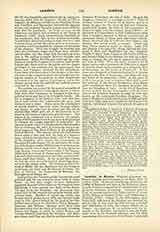

Loja, Diocese of (LOJANA), suffragan of Quito, Ecuador, includes the greater part of the Provinces of Loja and El Oro. It thus occupies the southwestern portion of Ecuador, lying between the summit of the Andean Cordilleras and the Pacific Ocean. It has an area of about 10,000 square miles. The city of Loja, which has a population of ten thousand, is situated some 270 miles S.S.W. of Quito, in the Val de Canbamba. It was established about the year 1546 to protect travellers on the royal road from Quito to Peru against the attacks of the Indians, and is thus one of the oldest towns in the state. In 1580 the First Provincial Council of Ecuador was held there; at which time the city contained, in addition to its parish church, a Franciscan convent and a Dominican priory. It was at Loja that the valuable properties of the cinchona-bark, the source of quinine, were first discovered by a Spanish soldier who, having accidentally experienced its antipyretic qualities, by means of it cured the vice-reine of Peru, the Countess of Chinchon (a quo cinchona), of a fever, and thus made it known to the world. Loja suffered much from earth-quakes and Indian inroads. In 1861 it possessed a Jesuit church, a college, a consistorial house, and an hospital. Five years later a bishopric was erected at Loja, Msgr. Checa being the first occupant of the see; he was succeeded by Msgr. Riofrio, afterwards Archbishop of Quito; the third prelate was Msgr. Jose Masie, O.F.M.; born on January 14, 1815, at Montroig, in Tarragona, Spain, he was consecrated Bishop of Loja on September 16, 1875. This illustrious prelate died in 1902 in Peru, a glorious exile for the Faith. After an interregnum of several years, Msgr. Juan Jose Antonio Eguiguren-Escudero, the present ordinary, was appointed. Msgr. Eguiguren was born at Loja on April 26, 1867; he studied at the semi-nary of Quito, where he was ordained on June 11, 1892. Shortly afterwards he became a professor in his Alma Mater; in 1901 he was named an honorary canon, and three years later was made Administrator Apostolic of Loja; on March 6, 1907, he was elected to fill the vacant see and was consecrated at Quito on July 28, 1907. The Diocese of Loja contains 61 secular priests, 20 regulars, 84 churches or chapels, and 36 parishes. There are two colleges, and in the town of Loja a convent for the higher education of women. The Catholic population is about 81,000.
With the exception of individual cases, there is no religion professed in the diocese but Catholicism (and paganism among some of the Indians); many of the Catholics, however, are lukewarm and the Church is suffering from the increasing hostility of the advanced Liberal or Radical party at present in power in Ecuador. The following remarks will help to make known the present (1909) position of the Church. The State and the Church have been separated, and all religions are now equal before the law; there is no interference with communications between the clergy and the Holy See. The secular priests were formerly supported by tithes, and later by a percentage of the import duties; now they are entirely dependent on the voluntary contributions of the faithful. Clerics are exempted from military service, but they may not hold any civil-public office; they are forbidden to preach against enactments of the legislature, or against the political parties, under a maximum penalty of a fine of 100 sucres (florins) and imprisonment for 30 days. None but a native-born Ecuadorean may be preferred to any ecclesiastical dignity. So far ecclesiastical property has not been confiscated by the secular power, though it is under state control. A religious organization has to obtain permission from the Government before it can legally receive and hold gifts or legacies. enclosed orders are to disappear gradually, being forbidden to accept any more novices; but teaching and charitable institutes may receive postulants provided they are over eighteen years of age; these bodies, however, are not allowed to found new houses in the State. Civil marriage alone is recognized by the State, and must precede the religious ceremony if there be any. Priests who violate this provision of the law are liable to a fine of 500 sucres and imprisonment for three months for a first offense, and 1000 sucres and six months for a second. Education, to which the secular authorities were until recently indifferent, and which was therefore provided for by the energy of the clergy, is now compulsory and gratuitous for children between the ages of six and twelve. The Liberal Government testified officially (in 1900) to the great zeal displayed by the religious teachers and the success that attended their efforts; since then, however, the State has established godless schools; yet parents are free to send their children to the church schools. The public authorities are forbidden to contribute to the support of the latter.
Only a very small proportion of the population of the diocese is of pure white origin, the remainder being a hybrid race of mixed Spanish, Indian, and Negro blood, known as cholos, zambos, or mestizos, with many pure-blooded Indians. The climate of the diocese varies from a mean of 18° C. in the higher regions to torrid heat on the slopes of El Oro to the ocean. Trade consists mostly in cereals, coffee, sugar, cinchona, and mules; there is considerable mining at Zaruma. The principal towns are Machala (5000 inhabitants), Santa Rosa, Zaruma, and Loja.
A. A. MACERLEAN

